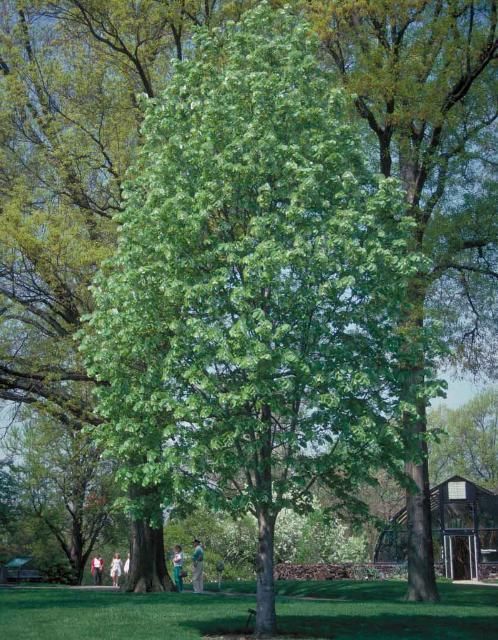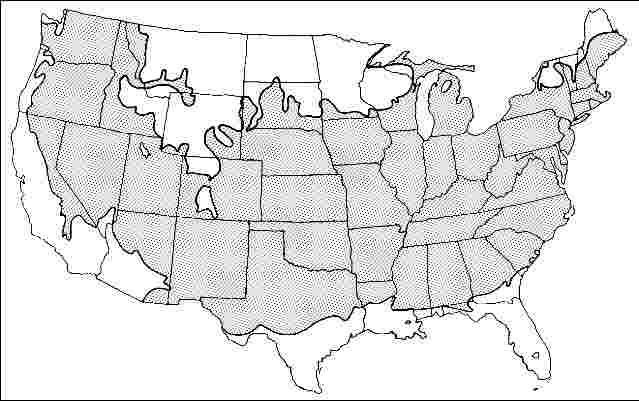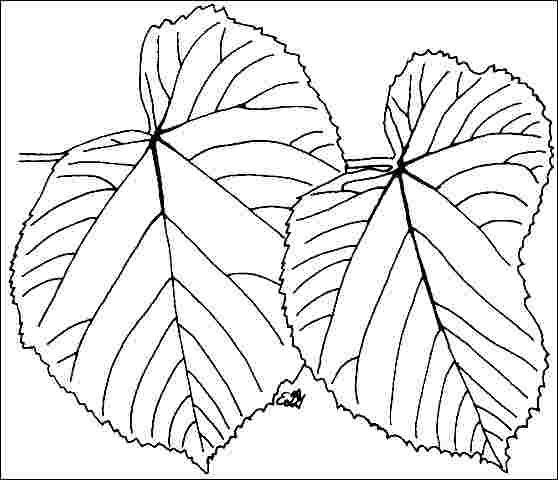Tilia tomentosa: Silver Linden1
Introduction
Rapidly growing 50 to 70 feet in height with a spread of 40 to 60 feet, silver linden could be quite popular for use as a shade, specimen, or street tree. A deciduous tree, silver linden has a pyramidal form when young but develops into an upright silhouette with an oval canopy and often has multiple trunks. Casting dense shade below the tree, the four to five-inch-long dark green leaves are bright silver and fuzzy below, causing the trees to almost appear as if they are shimmering with each little breeze. The leaves turn yellow before dropping in autumn. In early summer, the trees are perfumed with extremely fragrant clusters of small, yellow/white blossoms but these are difficult to see due to the dense cover of the large leaves. The flowers attract large numbers of bees and a small, egg-shaped fruit follows the blooms.

Credit: Ed Gilman, UF/IFAS
General Information
Scientific name: Tilia tomentosa
Pronunciation: TILL-ee-uh toe-men-TOE-suh
Common name(s): Silver linden
Family: Tiliaceae
USDA hardiness zones: 4B through 8A (Fig. 2)
Origin: not native to North America
Invasive potential: little invasive potential
Uses: hedge; urban tolerant; parking lot island > 200 sq ft; shade; specimen; street without sidewalk; parking lot island 100-200 sq ft; tree lawn > 6 ft wide; highway median
Availability: somewhat available, may have to go out of the region to find the tree

Description
Height: 50 to 70 feet
Spread: 40 to 60 feet
Crown uniformity: symmetrical
Crown shape: oval, pyramidal, round
Crown density: dense
Growth rate: fast
Texture: coarse
Foliage
Leaf arrangement: alternate (Fig. 3)
Leaf type: simple
Leaf margin: serrate, double serrate
Leaf shape: cordate, ovate, orbiculate
Leaf venation: pinnate
Leaf type and persistence: deciduous
Leaf blade length: 2 to 4 inches, 4 to 8 inches
Leaf color: green
Fall color: yellow
Fall characteristic: not showy

Flower
Flower color: yellow
Flower characteristics: showy
Fruit
Fruit shape: oval
Fruit length: less than .5 inch
Fruit covering: dry or hard
Fruit color: tan
Fruit characteristics: does not attract wildlife; not showy; fruit/leaves not a litter problem
Trunk and Branches
Trunk/bark/branches: branches droop; not showy; typically one trunk; thorns
Pruning requirement: needed for strong structure
Breakage: resistant
Current year twig color: brown, green
Current year twig thickness: medium
Wood specific gravity: unknown
Culture
Light requirement: full sun, partial sun, or partial shade
Soil tolerances: clay; sand; loam; alkaline; acidic; well-drained
Drought tolerance: moderate
Aerosol salt tolerance: moderate
Other
Roots: not a problem
Winter interest: no
Outstanding tree: yes
Ozone sensitivity: tolerant
Verticillium wilt susceptibility: susceptible
Pest resistance: resistant to pests/diseases
Use and Management
This tree is large and needs plenty of room to develop. Plant it as a specimen or shade tree on a commercial property where there is plenty of soil space available for root expansion. Well-suited for large tree lawns along streets and for large parking lot islands. Be prepared to remove sprouts periodically from the base of the trunk.
Silver linden should be grown in full sun on moist, well-drained soil, acid or slightly alkaline. This tree is moderately tolerant of pollution, soil compaction, heat, and drought making it an ideal street or shade tree. It appears to tolerate drought better than other lindens. Some report that it is risky to transplant in the fall. Irrigate regularly following planting.
Available cultivars include: 'Green Mountain', a rapidly-growing form with a dense canopy and is reportedly resistant to Japanese beetle and gypsy moth; 'Princeton' reportedly compartmentalizes decay bettern than others; 'Sterling', reportedly resistant to gypsy moth and Japanese beetle; and 'Wandell', broadly pyramidal form, leaves reportedly resistant to Japanese beetle.
Propagation is most often done by cuttings, or by seed with difficulty (can take two years to germinate).
Pests
Mainly aphids are problems although European linden bark borer, linden borer, walnut lace bug, caterpillars, basswood leaf miner, elm sawfly, scales, and Linden mites can all be serious problems. The aphids will secrete a honeydew which will result in a dark soot over objects below the tree, such as parked cars or lawn furniture.
Reportedly less susceptible to Japanese beetles than other lindens due to the pubescense on the under side of the leaves.
Diseases
Anthracnose, leaf blight, canker, leaf spots, powdery mildew, and verticillium wilt can be occasional problems on lindens.


